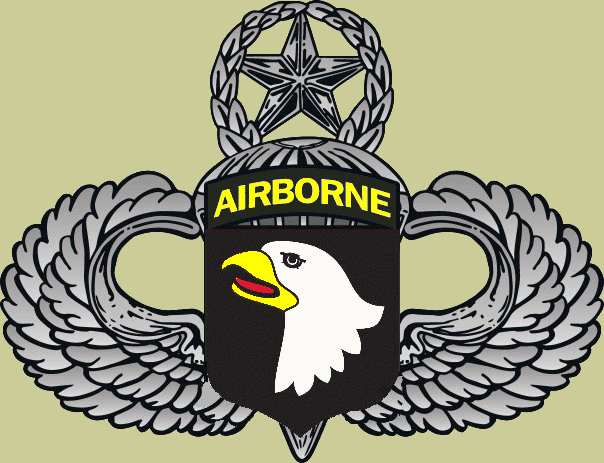
101st
Airborne Division
(In the
Second World War)
The 101st Airborne Division was originaly known as the 101st
Infantry Division, with a history that went back as far as the
American Civil War. As an Airborne Division it became active on
16 August 1942, under the command of Major-General William
Carey Lee, with Brigadier-General Don F. Pratt as his
assistant. For education they went to Toccoa, Georgia. They
underwent murdering marches while running uphill the Currahee.
The Indian name, ‘Currahee’ stood for 'We Stand Alone' and was
adopted as the war cry for the 506th Parachute Infantry
Regiment. Beside the 506th, there were two other infantry regiments; the 501st and 502nd PIR.
Other units connected to the 101st were the 327nd Glider Infantry Regiment, the 81st
Airborne Anti-Aircraft and Anti-Tank Battalion and four artilleriebattalions
(377th en 463rd Parachute Field Artillery and the 907th an 321st Glider Field Artillery).
At Fort Bragg the 101st exercised in parachute
jumping with the 82nd Airborne Division. In June
1943 the 101st Airborne Division went to Tennesee. Here they
practised in mass jumps and with gliders.
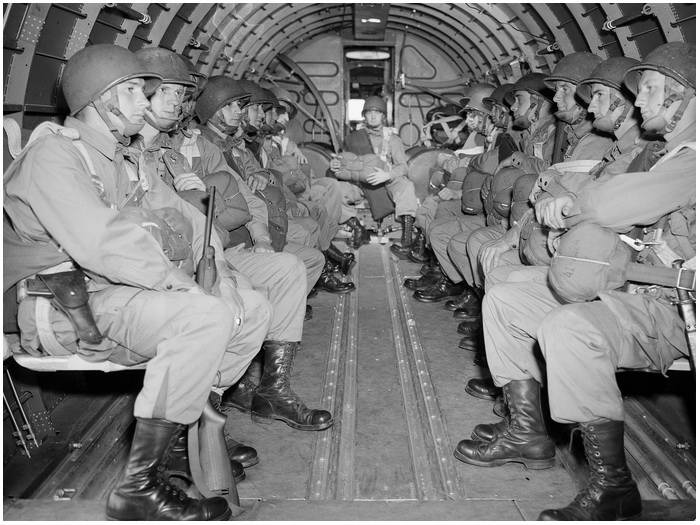
Paratroopers of the 101st Airborne during training
THE SCREAMING
EAGLE
(S.R.Loboda)
We have a rendez-vous with destiny.
Our strength and
courage strike the spark,
That will always make men
free.
Jump right down through the skies of blue,
keep
your eyes on the job to be done.
We're the men of the
hundred first,
we'll fight till the battle is
won.
Screaming Eagles diving from the sun,
striking
boldly from the air.
Now is it time to jump.
Look out
below !
Stand up ! Hook up !
Screaming Eagles, go !
By August 1943 the 101st Airborne Division is considered as
a capable fighting machine. The unit leaves for New York and
boards for Liverpool. After arrival it goes by train to
Newbury, their base and headquarters. They continue their
training and prepare themselves for the invasion in Europe.
6 JUNE 1944, D-DAY
101st Airborne Division will jump together with the 82nd
over the peninsula Cotentin. The objective for the 101st is to
protect the flanks of UTAH Beach and prevent that the
Germans can bring in reinforcements and destroy artillery that
is placed inland. Due trough an illness, which hits General
Lee just before the drop into Normandy, General Pratt is
appointed as his replacement. He will be flying into Normandy in a WACO called The Fighting Falcon.
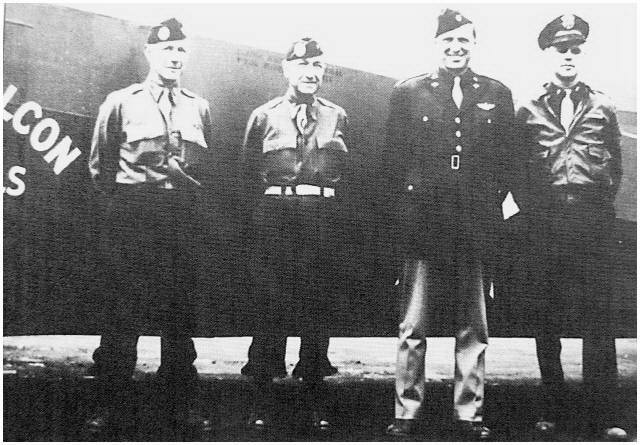
General Don Pratt stands 2nd from left in front of the WACO The Fighting Falcon
Supreme Commander Dwight
Eisenhower visit the men of the 101st Airborne Division on 5
June and points out to the ‘Eaglemen’, that success on D-Day
depends on the determination of the airborne troops.
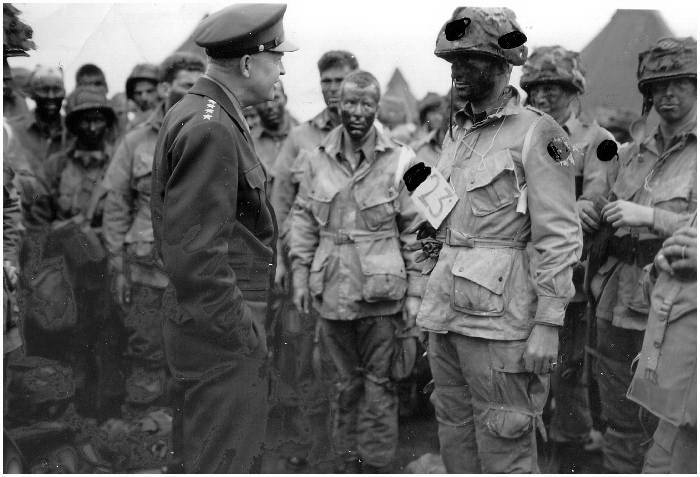
Eisenhower wishes the 'Eaglemen' of the 502nd PIR success
(The para with '23' is Lt. Wallace C. Strobel)
In the evening of the 5th the men board their C-47’s and
gliders. When they reach the coast of Normandy a curtain of
anti-aircraft fire welcomes them. Many pilots have to unhook
their gliders when their C-47 is hit by flak. Gliders and C-47's crash in the
English Channel and in the fields of Normandy. But most pilots
push through the barrage of fire and look for their dropping
zone (DZ) and landing zone (LZ). The formation is broken up
due to the fierce flak and pilots try to reach higher
altitude and fly faster. The calculated corridor of a few kilometres is widened
to 20 kilometres. The paratroopers
jump in scattered ‘sticks’ over an immense area.
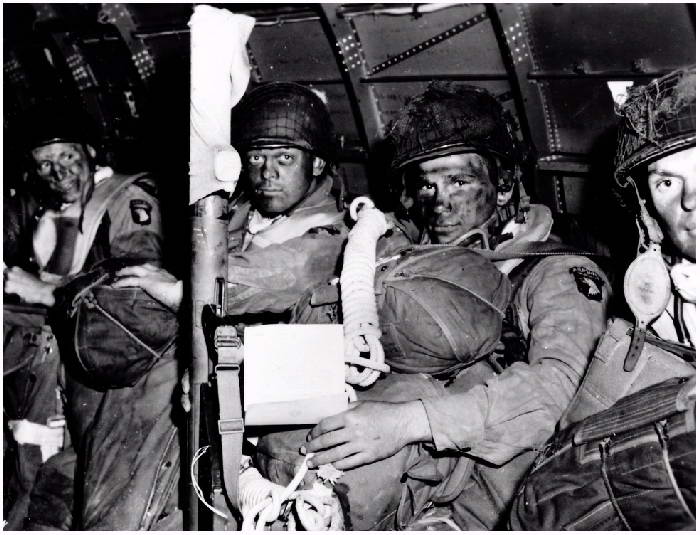
F Comp.,
2nd Bn, 506th PIR, 101st Airborne Division. Underway to Normandy
in C-47 #12
of the 439th Troop Carrier Group from 'Upottery'.
At 01.20 hours they jumped over DZ " C " (Hiesville)
(l. to r.:
William G. Olanie, Frank D. Griffin, Robert J. Noody, Lester T. Hegland)
It is impossible to form a coherent unit after the jump.
Everywhere are small groups fighting with surprised Germans,
often man to man.
The paratroopers of the 82nd and 101st had some
terrifying experiences that night. Many die in their planes
because of German flak or while they hang under their
parachute or drown in flooded area’s.
 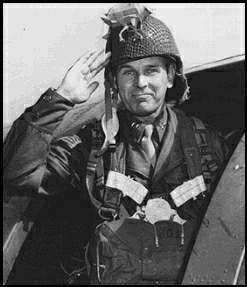
Monument for General Pratt, and Major-General
Maxwell Taylor
General Pratt, who just was given the command over the 101st, got
killed when his glider crashes. Near the crashsite is a monument, you may find it at the crossroads
of the D 129 (Turqueville) and the D329 (Hiesville) near La Croix Pan. Major-General Maxwell Taylor
takes over the command.
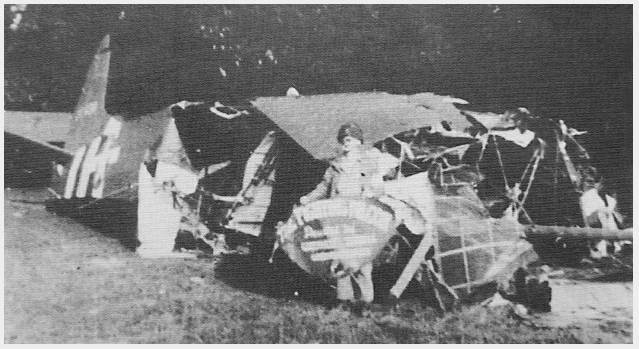
The wreck of the glider of General Pratt
General Pratt was not the only officer who lost his life during the
'fly-inn' over the Cotentin. Another officer who perrished with his whole stick of men, and C-47 crew,
was Lt. Thomas Meehan III, commander of 506th Easy Company.
Meehan had replaced Capt. Sobel just before D-Day to lead Easy Company. But disaster struck, when
at 00.15 uur the C-47 #66, of the 439th Troop Carrier Troop, was hit by anti-aircraft shells.
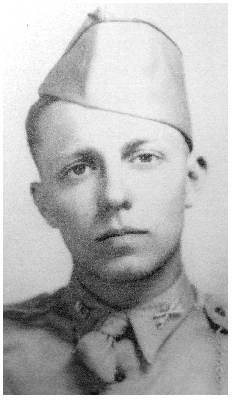 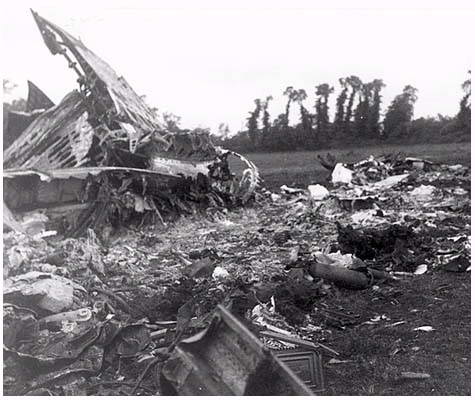
Lt. Thomas Meehan and the crashed C-47
The plane crashed in a field behind the church of Beuzeville-au-Plain. Beside the 17 paratroopers, the four
crew members were also killed.
Easy Company got a new commander in Lt. Dick Winters (see lower).
On June 6, 2000 a monument was revealed near the church of Beuzeville-au-Plain (a few miles east of St. Mère-Eglise),
has the shape of the tailplane of a C-47. Behind the bronze plaque is a small urn
with some ashes of the crashed C-47.

The monument for the crashed
C-47 at Beuzeville-au-Plain
The last letter from Thomas Meehan to his wife:
Dearest Anne:
In a few hours I’m going to take the best company of men in the world into France.
We’ll give the bastards hell. Strangely, I’m not particularly scared. But
in my heart is a terrific longing to hold you in my arms.
I love you Sweetheart - forever.
Your Tom
- Heroes in action -
There were two remarkable actions the first days after the
landings in Normandy performed by units from the 101st
Airborne Division. In the early morning of 6 June, a artillery
battery near Ste-Marie-du-Mont, on the estate
of Brécourt Manor, is firing at Utah Beach with four 105mm
cannons. Easy Company, a unit of 506th PIR, 101st Airborne
Division, gets the assignment to silence this battery.
 
Brécourt Manor, Then and Now
Eleven
men under command of Lieutenant Dick Winters capture in a swift
action three cannons and destroy these. The fourth is captured
and destroyed by Lt. Peirs and 5 extra men from Dog Company.
Fifteen German paratroopers, who were operating the cannons,
are killed, numerous wounded and twelve were taken prisoner.
Winters unit suffers four men killed and two wounded. The site of the battle can be found at the first lane on the left from the D 14, a mile north of Ste-Marie-du-Mont. See for
the complete story ‘Band of Brothers’, by Stephen E. Ambrose, page 78 to 86.
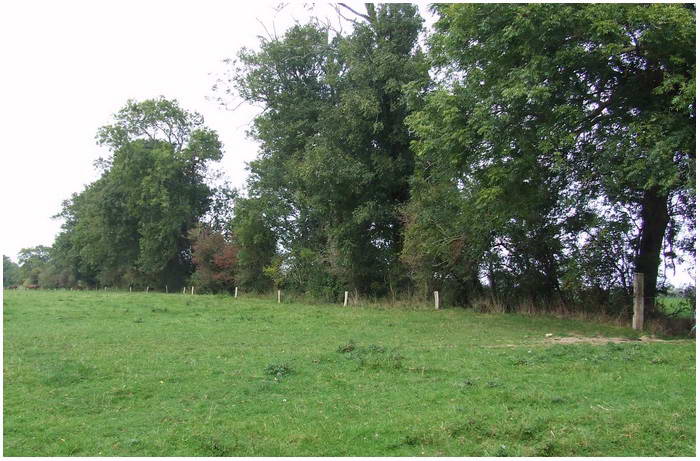
The site of the four 105mm guns, Then and Now
Through Wilco Gaal I received in 2008 a picture if the remnants of the guns that were destroyed by the 506th.
The pieces of the cannons are to be found in the courtyard of Brécourt Manor.
Doesn't belong they's artefacts in a museum before they are lost?
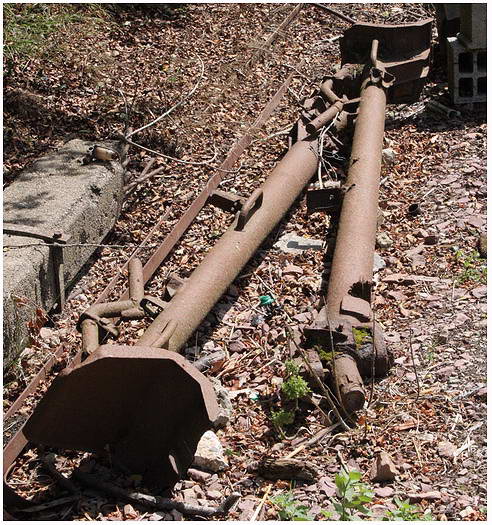 The remnants of the guns at Brécourt Manor
(foto; Wilco Gaal)
The remnants of the guns at Brécourt Manor
(foto; Wilco Gaal)
A similar action was fought at the southwest of Ste-Marie-du-Mont. This action would
become known as the elimination of Battery Holdy. In the early hours of June 6, Captain Knut
Raudstein en Captain Patch moved out with a section of 1st battalion 506th PIR, heading for Holdy.
Around 50 to 60 Germans were here, overseeing their artillery battery.

The guns at Holdy are taken
The para’s split into two groups to surround the german stronghold. The battle was chaotic and the Germans
tried to retread from their entrapment. One of the troopers fired a Bazooka, and the rocket flew into an
ammunition pile, which exploded with an enormous bang. This was the signal for the last Germans to surrender
while a large quantity was lying dead in a ditch.
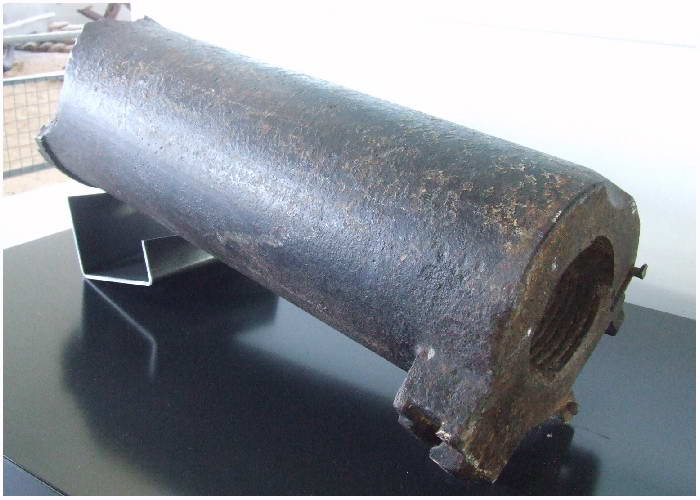
A piece of a canon from the Holdy battery
is on show
at the Utah Beach Museum
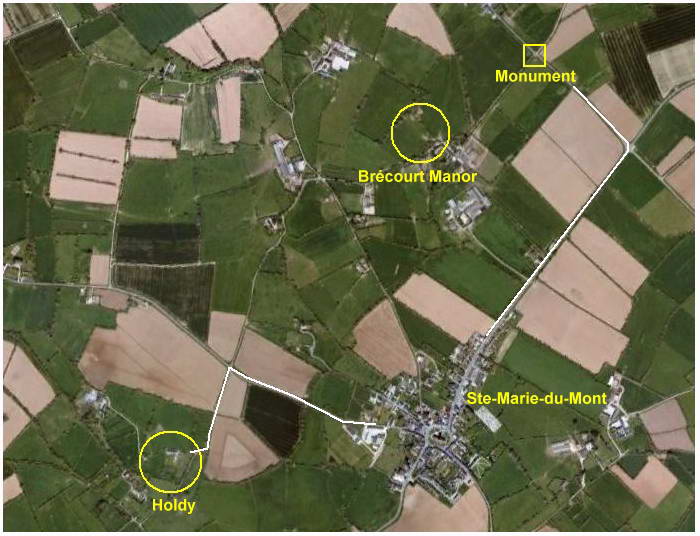 A map with the positions of the batteries
A map with the positions of the batteries
Another action was the attack and capture of Carentan. The 502nd Parachute
Infantry Regiment fights this attack in close combat.
Lieutenant-Colonel Robert Cole leads his men in a frontal
attack into Carentan. With fixed bayonet they fight a
ferocious battle with the Germans. It is the first bayonet
charge of the Second World War for American troops in Europe.
It was not the first impressive action for Cole. On 6 June he
positions himself with men from 502nd PIR and 3rd Battalion
near 'Exit 3' of Utah Beach. During an exchange of fire they
kill 75 retreating Germans on the road that is now called
‘Blair Road’.
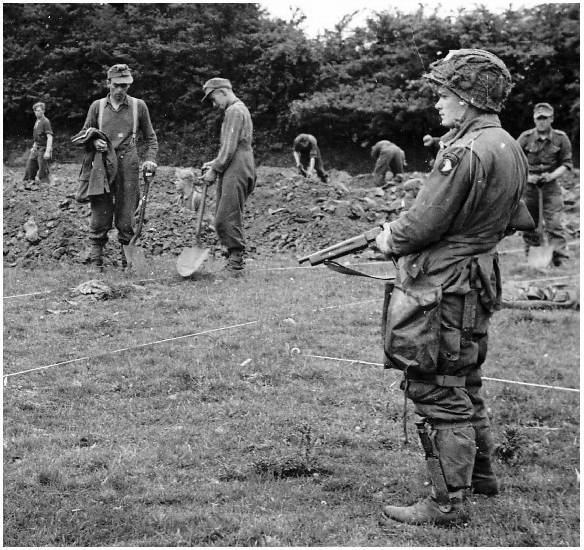 A paratrooper guards German
prisoners will they are digging graves
A paratrooper guards German
prisoners will they are digging graves
for the killed men who died while fighting for the Cotentin
Lieutenant Winters is with his Easy Company on
the frontline as well for the capture of Carentan. Here, Winters
gets slightly wounded in the leg. Winters and Cole are both nominated for
the Congressional Medal of Honour. But due to the rule that
only one man per division can get this distinction, Lt.-Col.
Cole is chosen.
  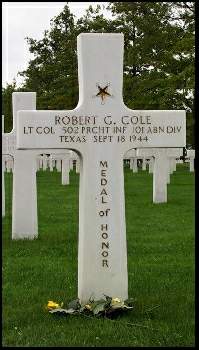
f.l.t.r. de Medal of Honor, Robert G. Cole and his
grave at Margraten, Holland
(pict. Mark
Handels)
Lt-Col Robert Cole was killed on September 18th,
1944 during Operation ‘Market-Garden’. He had not yet received
his Medal of Honor by that time. His mother got his medal out
the hands of Major-General Jonathan W. Anderson on
October 30th, 1944. Lt-Col Cole's grave can be found at Margraten,
Holland.
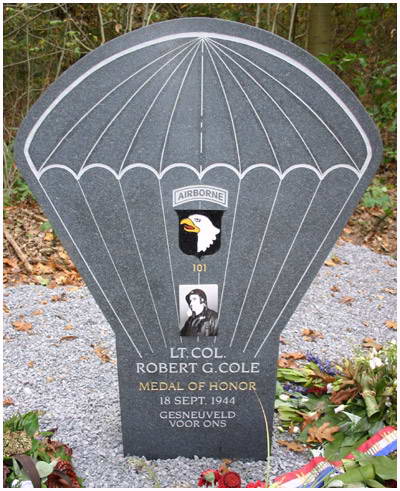 The monument
at Best, Holland for Lt.Col. Cole
(foto; Guus Slenders)
The monument
at Best, Holland for Lt.Col. Cole
(foto; Guus Slenders)
I received a picture from Guus Slenders of the monument that was erected in Best, Holland to honour Lt.Col. Cole.
Another operation may not be forgotten. 575 paratroopers left in the evening of June 5-6, 1944 in
fourty five C-47’s from 440th Troop Carrier Groupto Drop Zone ‘D’ near
Angoville-au-Plain. Target for these outfit were two bridges at Le Port.
They had to secure these bridges, so the Germans could not counter attack
across these bridges, and jeopardize Utah Beach. Later these bridges could
be used as extra roads towards Omaha Beach. This ordeal deserves a page of its own:
'FILTHY 13, CLICK HERE
Besides the medals received by para's who did more than their jobs, most
units from the 101st Airborne Division received
the Presidential Unit Citation
for their effort to capture
Carentan.
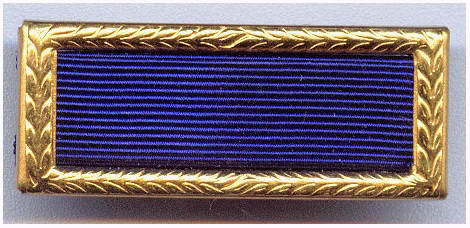 Presidential
Unit Citation
Presidential
Unit Citation
SEPTEMBER 17, 1944,
MARKET-GARDEN
During a short period of rest, after D-Day, the depleted
ranks of the 101st are brought up to strength in England and
they commence the training for ‘Operation Market-Garden’. The
DZ for the 101st is at Veghel, near Eindhoven. As part of the
1st Airborne Army, they participate in the biggest airborne
operation till then. When the last transport planes leave
England, the first ‘sticks’ jump over Holland. Other than on June 6th, 1944,
D-Day, the pilots keep their planes on course, despite the
German flak. The three Parachute Infantry Regiments, 501st,
502nd and 506th must capture the bridges near Eindhoven, Son
and St Oedenrode. The 506th is too late to take the bridge at
Son, it is blown by the Germans, but they capture the bridge
near Eindhoven. The other bridges are captured as well by
units of the 101st Airborne Division.
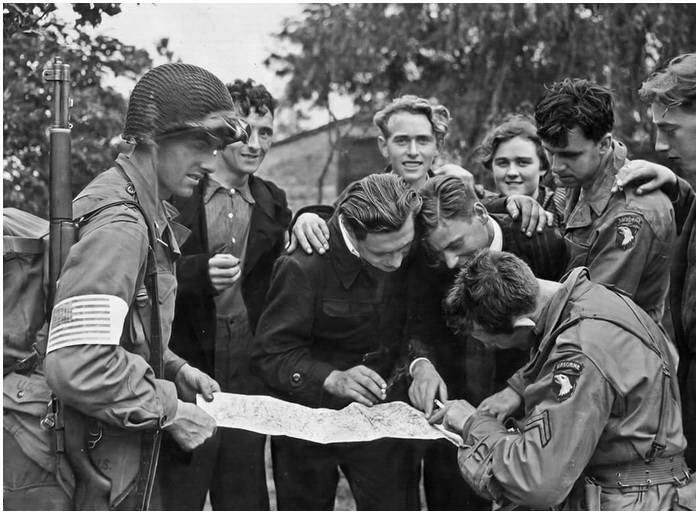
Civilians in Eindhoven point the way for the 101st
On the third day during
the operation, German bombers appear over Einhoven. Their
bombs kill at least 200 civilians. Veghel is hit badly by
German artillery. The Germans manage to cut off ‘Hells
Highway', the present-day N265, a couple of times. But the
paratroopers retrieve it every time back from their enemy. It
is a long and exhausting battle.
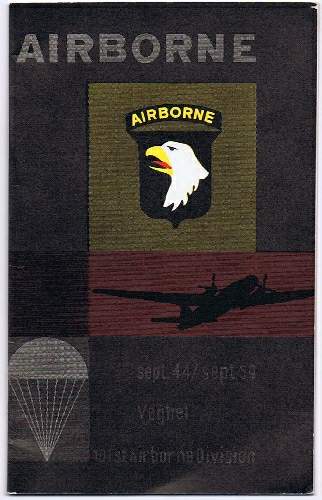
Remembrance
booklet from Veghel, 1959
On October 2, 1944, Easy Company of the 506th PIR, 101st Airborne Division took up
their positions on the so called ‘The Island’, just north of Zetten, global from Heteren
to Opheusden. These positions were taken over from the British 43rd Division, which stayed
here after the loss of Arnhem-Ooosterbeek. On October 5, the fight for the 'Crossroads'
took place. A patrol from Easy Company ran into a German machinegun, which was eliminated
that same night by a larger Group under the command of Captain Winters.
During another attack on this crossroad in the morning, a great number of casualties
was brought to a company of SS, who were hiding behind a dyke,and who were planning an attack on the paratroopers
to get them of 'The Island'.
Winters, who planned the whole attack against these German opostion, thought that this was his best strategic plan
he thought of, something he was proud of.
FOR THE COMPLETE STORY ON 'CROSSROADS'
CLICK HERE
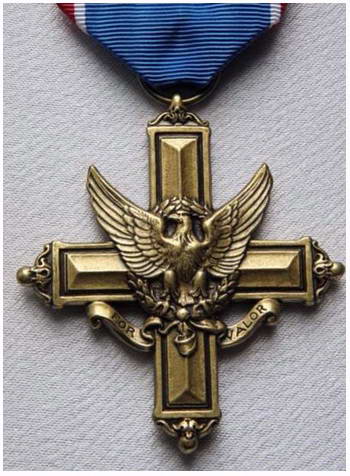
A remarkable action is performed on October 29 1944, when 6
men of the 501st PIR undertook a patrol. In two rubber
dinghies they cross the river Rhine near Renkum. During the
day they keep in hiding aside the road between Arnhem and Ede.
The following night they capture 32 Germans and take them with
them back across the Rhine. For the observations on the German
positions and the capture of the 32 Germans, Captain
Hugo Sims jr. receives the Distinguished Service Cross.
The
Distinguished Service Cross
Of the 13.112 men of the 101st dropped on September 17,
2356 of them are put out of action by September 27. In 10 days
there are 373 killed, 1436 wounded and 547 are missing. They
took 3511 German prisoners. When the 101st Airborne
Division on November 28th, 1944 is pulled back, they prevented a
breakthrough from the Germans to Antwerp. Unaware of what lies
ahead in the Ardennes, the men retire to Mourmelon, France,
for rest and to bring the 101st back to fighting strength.
’THE BATTLE OF THE
BULGE’
Mid December 1944, while the 101st Airborne Division is
resting at Mourmelon, near Reims, the Germans launch a big
attack through the Belgium Ardennes and maybe make a
breakthrough all the way to Antwerp. On 18 December the 101st
is directed with 11.000 men to Bastogne. Surrounded by eight
German divisions they keep their positions. The battle for
Bastogne goes back and forth. Because of the shortage of
personal in the ranks of the 101st, even the cooks and clerks
are given a gun to fight the Germans. The paratroopers are
troubled by trench-foot and frozen limbs, but the men don’t
give up Bastogne.
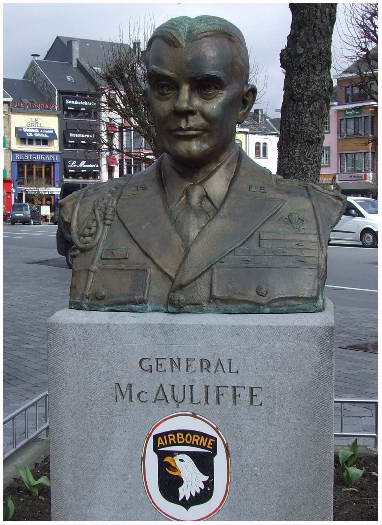
Bust of Brigadier-General Anthony C.
MacAuliffe in Bastogne
The 101st is that determent, that a request
from the Germans to surrender to them is not even taken
seriously. Brigadier-General Anthony C. MacAuliffe give the
Germans just one word to ridicule the request, ‘Nuts!’. When
finally on December 26, 1944, the American 4th Armoured
Division make contact with the stricken troops of the 101st,
the fierce fighting seems to have come to an end. The
war-correspondents are shocked when confronted with de
devastation and call it the ‘Alamo of Europe’. The troops of
the 101st give themselves the title : ‘Battered Bastards of
the Bastogne Bastion’.
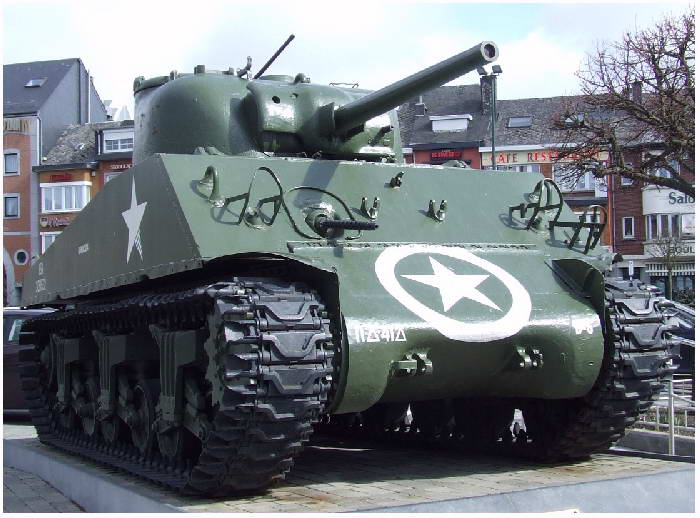
Place MacAuliffe in Bastogne with
the M4A3 Sherman tank
The 101st Airborne Division goes from the defence into the
offensive and storms Foy and Noville and some other small
towns north of Bastogne. On January 19, 1945 (the losses are
by then 3460 men) the 504th PIR receives the Presidential Unit
Citation Streamer, and the whole of 101st Airborne
Division receives the Distinguished Unit Citation, from the Supreme
Commander Eisenhower, for their gallantry and determination.
Unique in the American army, normally only units from
regiments receive the DUC.
’WHY WE FIGHT,..’
At the end of April, 1945, the 101st stormed through the Bavarian Alps. On April 27,
when they reach Buchloe, near Landsberg,they run into a concentration camp. It is filled with walking skeletons.
It is a sub-camp for Dachau, with 5000 starving men, who seem barely alive. Here realize the troopers why they
fight in Europe.
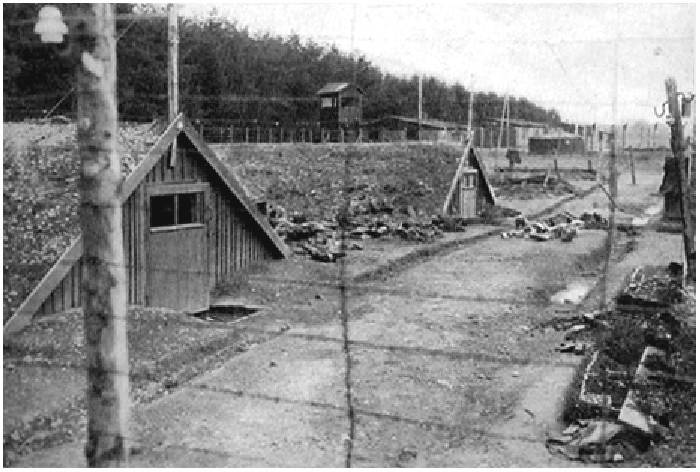
The sub-camp from Dachau near Landsberg
General Taylor ordered the press to take notice of the beastly business that took place in this camp.
Also the German civilians from the area are ordered to come to the campo, and bury the dead bodies in the
camp with their bare hands.
TO THE EAGLESNEST
The 101st division
meanwhile capture some politic and military big shots form the
diminishing Third Reich, such as; Robert Ley, Julius
Streicher, Xavier Schwartz, Luftwaffe Feldmarschall Albert
Kesselring and SS General Berger.

The Eaglesnest, Obersalzberg;
101st Airborne troopers relax
Via Berchtesgarden (where
they discover the treasures ‘from’ Göring) it is up to the
summer residence of Hitler. The 506th PIR is the first to
arrive at the ‘Eaglesnest’.
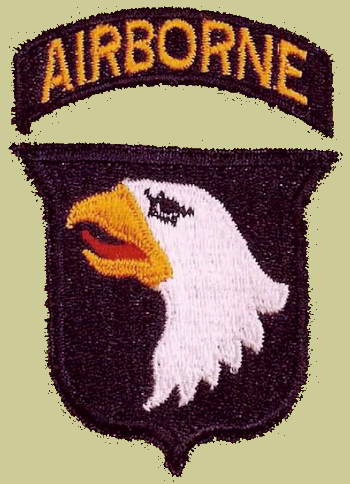
Left, the shouderpatch of the 101st Airborne Division
Units from the 101st are later
stationed in Austria, just across the border with Germany. On
1 August 1945 the 101st is brought back to France with the
purpose to go in training for battle in Asia. But Japan
capitulates 10 days later and the war is at last over for the
101st Airborne Division.
The original shoulder sleeve insignia for the 101st
Infantry Division is accepted on 23 May 1923. Pictured on a
black shield is a screaming ‘Bald Eagle’. On 28 August 1942,
when the division becomes an airborne division, there is a
half circle placed above it with the word ‘Airborne’. The
original 101st has a history that dates back to the American
Civil War. The black shields reminds to the ‘Iron Brigade’
from Company C, the ‘Eau Claire Eagles’ of the 8th Wisconsin
Regiment. These owned a mascot, an eagle called ‘Old Abe’.
Legend says, that a Chippewa Indian, Chief Sky, swapped the
young chick for a sack of corn in 1861. Someone else bought
the bird for $4 and donated it to Company C, 8th Wisconsin
Regiment. The eagle was transported on a shield and was
present at 36 battles. The bird was wounded on two occasions,
at Vicksburg and the Battle for Corinth. The 101st Airborne
Division adopted an eagle as well and called the animal
‘Young Babe’. When the division was on training in Tennessee,
the bird dies unfortunately at Fort Bragg.
MARCH OF THE 101ST
AIRBORNE
DIVISION
(S.R.Loboda)
Go you Screaming Eagels
Drop through the sky.
Never
let your strenght and gourage fail,
and as you hit, keep
going
with that Bastogne spirit,
wich has carried
freedom’s grail.
Come on, let’s go, you Screaming
Eagles
Fight for the right to be called a son
of the
one-o-one !
So here we go.
You know, the Eagles are
diving from the sun.
Look out for the mightiest men of
Geronimo !
To the 82nd 'All American' Airborne
Division.
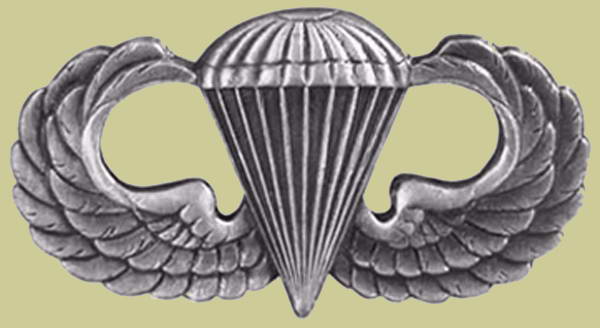
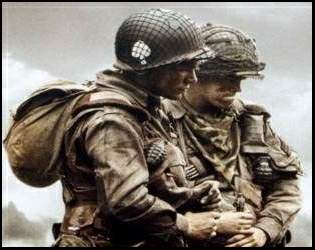 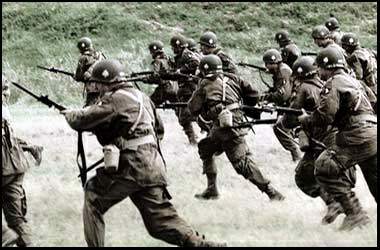
From the
tv-series 'Band of Brothers', notice the stencils on the helmet.
Maybe you did notice the symbols that the paratroopers had on their helmets?
Do you want to know more what these stencils have to tell,
'CLICK HERE'
RETURN
|